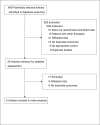Efficacy of intensive control of glucose in stroke prevention: a meta-analysis of data from 59,197 participants in 9 randomized controlled trials
- PMID: 23372729
- PMCID: PMC3553082
- DOI: 10.1371/journal.pone.0054465
Efficacy of intensive control of glucose in stroke prevention: a meta-analysis of data from 59,197 participants in 9 randomized controlled trials
Abstract
Background: The efficacy of treatments that lower glucose in reducing the risk of incident stroke remains unclear. We therefore did a systematic review and meta-analysis to evaluate the efficacy of intensive control of glucose in the prevention of stroke.
Methodology/principal findings: We systematically searched Medline, EmBase, and the Cochrane Library for trials published between 1950 and June, 2012. We included randomized controlled trials that reported on the effects of intensive control of glucose on incident stroke compared with standard care. Summary estimates of relative risk (RR) reductions were calculated with a random effects model, and the analysis was further stratified by factors that could affect the treatment effects. Of 649 identified studies, we included nine relevant trials, which provided data for 59,197 patients and 2037 events of stroke. Overall, intensive control of glucose as compared to standard care had no effect on incident stroke (RR, 0.96; 95%CI 0.88-1.06; P = 0.445). In the stratified analyses, a beneficial effect was seen in those trials when body mass index (BMI) more than 30 (RR, 0.86; 95%CI: 0.75-0.99; P = 0.041). No other significant differences were detected between the effect of intensive control of glucose and standard care when based on other subset factors.
Conclusions/significance: Our study indicated intensive control of glucose can effectively reduce the risk of incident stroke when patients with BMI more than 30.
Conflict of interest statement
Figures



References
-
- Williams GR, Jiang JG, Matchar DB, Samsa GP (1999) Incidence and occurrence of total (first-ever and recurrent) stroke. Stroke 30: 2523–8. - PubMed
-
- Yusuf S, Reddy S, Ounpuu S, Anand S (2001) Global burden of cardiovascular diseases, I: general considerations, the epidemiologic transition, risk factors, and impact of urbanization. Circulation 104: 2746–2753. - PubMed
-
- Ray KK, Seshasai SRK, Wijesuriya S, Sivakumaran R, Nethercott S, et al. (2009) Effect of intensive control of glucose on cardiovascular outcomes and death in patients with diabetes mellitus: a meta-analysis of randomised controlled trials. Lancet 373: 1765–72. - PubMed
-
- Jadad AR, Moore RA, Carroll D (1996) Assessing the quality of reports of randomized clinical trials: is blinding necessary? Control Clin Trials 17: 1–12. - PubMed
Publication types
MeSH terms
Substances
LinkOut - more resources
Full Text Sources
Other Literature Sources
Medical

